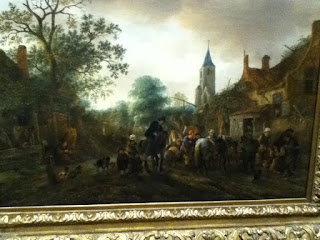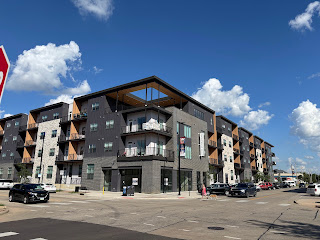| from nga.org |
 |
| Entrance to the Caillebotte show, Saturday 10/3/15 |
Yet Caillebotte's own attitude to the scene is marked by ambivalence, which becomes clear upon viewing five other Paris street scenes he painted during the same time period, between 1876 and 1880. He depicts a new Paris, produced in large part by Baron Georges-Eugene Haussman, a local official during the reign of Emperor Napoleon III. Haussman's public works program assaulted the medieval city with brio, smashing old structures and widening streets. He was Robert Moses a century before Moses would remake New York City, except that the technology of Haussman's day prevented him from building expressways. Whatever the value of cleaning up the "dirty, crowded and unhealthy" old city (Rice, quoted in "Haussman," cited below), it also removed places of meeting... which may have been Napoleon III's idea to begin with.
Caillebotte's Paris paintings show people who are disconnected from each other, walking wide streets by buildings large and unfriendly enough to draw the ire of a 19th century James Howard Kunstler. (Come to think of it, Kunstler's favored word for this kind of design, "despotic," is precisely what Napoleon III was.) The city is not human-scaled, and the people are alienated.
| "The Rue Halevy Seen from a Balcony," from wikigallery.org |
 |
| from wikiart.org |
 |
| "Venice 1" |
 |
| "Chicago Street" |
Caillebotte's ambivalence is underscored by his suburban and rural landscapes included in the exhibition. (See, for example, "The Bridge over the Seine at Argenteuil," painted in 1885.) There is still no socializing, but the colors are brighter and the skies clearer. Thanks to the commentary accompanying the exhibit, I can also tell you his brushstrokes were bolder.
The Paris we know and love today evolved out of Haussman's overhaul. Somehow over time urbanism and complexity reasserted itself. Maybe in an America beset by suburban sprawl our frame of reference is different, too.
SEE ALSO: "Physical Design Issues Illustrated" (on Hale Woodruff), 15 April 2013
SOURCES:
Holland Carter, "Painting Paris in a New, Natural Light," New York Times, 10 July 2015, C17 & 19
"Haussman and New Paris," https://www.mtholyoke.edu/courses/rschwart/hist255-s01/mapping-paris/Haussmann.html
Mary Morton and George Shackleford, Gustave Caillebotte: The Painter's Eye (Chicago, 2015)
 |
| Muddy but sociable: "The Halt at the Inn" by Isack van Ostade, c. 1645 National Gallery of Art |







No comments:
Post a Comment